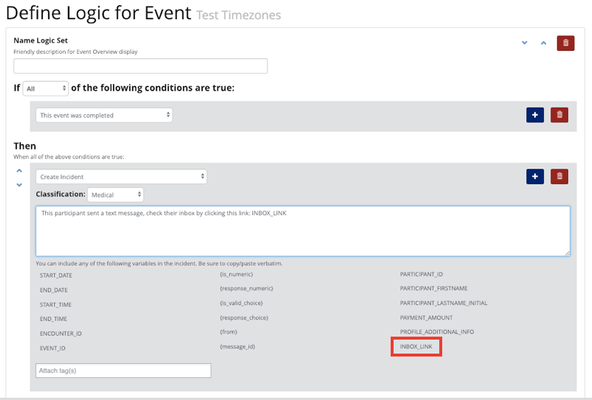| Widget Connector | |||||
|---|---|---|---|---|---|
|
...
|
...
|
I. Adding a New Device to Way to Health
1. Select the 'Devices' tab under Manage Study in Way to Health
...
5. Enter in the device credentials- username and password
Note: for some devices, WTH will let you 'save' the device even if the username and password are incorrect
Device Brand | Device Type | Does API Validate Credentials Upon Device Save? |
|---|---|---|
Pill Bottle | No | |
Clevercap | Pill Bottle | No |
Scale | No | |
Medsignals | Pill Box | Yes |
Pedometer | N/A | |
Water Bottle | N/A | |
iHealth | Glucometer | N/A |
Misfit | Pedometer | N/A |
Sleep |
N/A | ||
Inhaler | N/A | |
Twilio | SMS Receiver | N/A |
N/A | ||
Scale | N/A | |
Pedometer | N/A | |
Blood Pressure Cuff | N/A | |
Pill Box | N/A |
6. *NEW* Device Authorization Enrollment Step... is applicable if device set up is a requirement for enrollment. You should select whether or not a participant has to authorize the device, or if they can skip the set up
The participant must authorize this device: Used when device set up is part of the enrollment process and there is only one device option
How to Authorize devices:
Front End via the Participant Portal: Device authorization occurs when participants will enroll via the participant portal. They will need to enter their bluetooth device credentials into Way to Health when they are redirected to the products sign in page. Then participants will need to allow Way to Health to receive data from bluetooth device and can check-off what data we receive.
Back End via the Administrative Portal: Now you can authorize device accounts directly from the administrative portal! Authorization can be via the enrollment tab OR the devices tab if the participant has already completed enrollment. Simply click the "Authorize" button on the enrollment tab or devices tab and another tab will automatically open taking you to the devices authorization page as show above.
The participant will be given an option to skip authorization: Used when there are more than one device types that a participant can use so that they can skip over the step for the device that they are not using
Ex: a pedometer study using both Moves and Fitbit
7. Selection Strategy explanations can be found in How Device Data attaches to Events. However there are some general principles..
First: used for medication adherence devices
Last:
Min: used for weight loss studies
Max: used for physical activity studies
8. Selection Field determines which field of data WTH should use for a particular device to determine whether a participant completed or was compliant to the encounter
Ex: Clevercap pill bottle selection field should be IS_TAKEN, which will have the variables 0 and 1 for yes and no to determine encounter completeness and compliance
9. Attach data and close encounter... indicates when the encounter should close.
As soon data is available: will immediately close out the encounter once data is received and attaches to the open encounter.
Generally used for medication adherence devices
Wait until the end of the encounter window: encounter will not close until the end of the encounter window. This is ideal for devices where it may be typical to receive multiple data enteries throughout the course of the encounter.
Ex: leave Fitbit encounter window open so that WTH attaches the maximum number of steps walked to the encounter.
Ex: leave Nokia Scale encounter window open so that WTH attaches the minimum weight value to the encounter, regardless of how many times the participant steps on the scale.
10. When an already-completed encounter gets new data... determines what to do with new data
Attach new data in place of the old: If new data comes in after an encounter is completed, it will switch out the new data with original data
Ex: Fitbit participant doesn't sync their device until the following day, WTH will replace the '0 steps' with the # of steps that they walked
Stick with our original data:
WTHWTH should leave the original data that attached to the encounter
Used for medication adherence devices, SMS
11. Apply feedback... indicates what action WTH should take following new data
Only the first time data attaches: If any new data comes in during an encounter window that has already been completed, WTH will not do anything.
Each time a new data point attaches to an encounter: If any new data comes in during an encounter window that has already been completed, WTH will reapply feedback on the encounter for each data entry
II. Aggregator and Summarizer
See Aggregator for use case explanation and set up instructions
...
III. Way to Health integrates with a wide variety of data sources
Consumer devices
Medication Adherence
Vitality Glow Caps
Has a few different data types in WTH - cap openings, last communication time, dose adherence data
MedSignals
CleverCap
Inhaler sensor
Step Tracking
Fitbit - devices (such as Flex, One, etc) as well as the app.
Moves AppMisfit
Withings app
Weight Tracking
Withings scale
CleverCap scales
IncentaHealth scale
Blood Pressure
Withings cuff
Fluid Intake
Hidrate Spark water bottle
Participant Input
Surveys
Precommitment
Goal selection
SMS Receiver
Other data import methods
